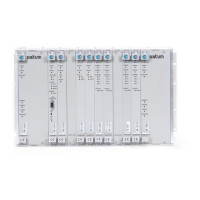12713020-002-2 Revision D – April 2004 SSU-2000 User’s Guide 29
Product Overview
System Architecture
System Architecture
The SSU-2000 system is a Timing Signal Generator that generates, monitors,
controls, and distributes network synchronization signals. These signals can be
DS1, E1, Composite Clock (CC), sinusoids, or square waves. The SSU-2000
continuously monitors incoming timing signal integrity. The operator defines input
acceptance criteria and sets parameters for alarming. If a reference signal is
acceptable (within the performance limits set by an operator), the SSU-2000
frequency-locks to the signal on a priority basis. System holdover and filtering
performance is dependent on the quality of oscillators used in the SSU-2000’s
internal clock modules (Stratum 2E or Stratum 3E).
A selection of hot-swappable modules and powerful software allows users to easily
configure, upgrade, or expand the SSU-2000 shelf to meet a variety of
telecommunications synchronization application requirements. Modules can be
inserted or removed from the SSU-2000 while the shelf is operational without any
degradation of output signals. Each module supports the management of critical,
major, and minor alarms. Output modules and clock modules can be configured in
redundant pairs for increased reliability.
A simplified block diagram for the SSU-2000 is shown in Figure 1-5.
Figure 1-5. Block Diagram of the SSU-2000

